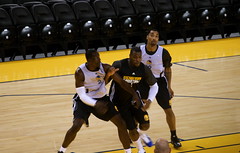Rebounding for Success: the Technique of Boxing-Out
There would be few coaches indeed that can afford to ignore the importance of rebounding. Rebounding is one of the most important aspects of the game of basketball. Even the best teams shoot mostly below fifty percent from the field, meaning that for every two shots attempted by the offense at least one rebound will be contested from a missed shot.

Rebounding is one of the last places where contact can be made between two players in a controlled, but still aggressive manner. In a heated rebounding situation the true strength and athleticism of players within basketball is on display. There is always space within a team’s roster for a tenacious rebounder and if the player can rebound on both ends of the floor they have a fantastic fundamental skill which is rare.
With the right technique there is no reason that undersized and less athletic players cannot compete and nullify their opponent’s strengths in rebounding. The strength in performing a successful box-out is in keeping the breakdown of the skill simple. The teaching points in focus will be Hit, Seal and Bury.
The first technical point in executing a box-out is the “Hit”. The hit refers to the initial contact made by the defensive player. This contact is necessary to try and stop the momentum of the offensive player as they attempt to crash the boards following a shot. The defensive player needs to use an arm bar to make contact with the chest of the offensive player. The force needed in this contact will take some time for defensive players to master as player have a tendency to not use enough force to stop the player which does not serve any purpose.
The defensive player should keep their centre of gravity low and wide while they step to make contact. The defensive player should step towards their target with the arm bar and lead foot on the same side of their body (for example left arm bar, lead foot will also be the left side).
Additionally the boxing out player must not take their eyes of their defensive assignment until contact is made. Any sooner and this provides an opportunity for the offensive player to change direction and not be seen.
The “Seal” teaching point refers to the player moving into a low and wide stance in front of the offensive player making it difficult for the player to move around to the basket. The placement of the lead foot is crucial to this part of the boxing-out build-up. The lead foot should be placed so it splits the offensive players two feet. An important point to highlight here is that the contact area for a left arm bar should be to the left hand side of the offensive player’s chest. This will see the player be pushed off balance allowing the lead foot (in this instance the left) to be pivoted on and a swing step executed, with the right foot to close the direct lane to the basket.
By the end of the seal movement the offensive player should have experienced two points of contact. The first is with the arm bar and second will be as the swing step is executed that the boxing-out players lower back hitting the offensive player and again reduces this player’s momentum and ability to force their way to the basket.
As the swing step is being executed by the defensive player their arms should start to rise so palms are at least at should height with both arms extended to help again in becoming the widest possible obstacle in the offensive player’s line to the basket. Carrying of the arms will also highlight for officials if the offensive rebounder makes a play for the ball over the back of the defender. This is common fouling situation in many basketball games at all levels of the sport.
The final stage in the rebounding battle will be the “bury”. The bury sees the defensive player shuffle with small steps in reverse backing up into the offensive player which creates further space between both players, the basket and the ball. This space has a number of benefits for the defensive player. By creating space the likely hood of the ball going long and overhead of the player will start to reduce the further the bury happens. Another benefit is if the rebound is short the defensive player will be in a commanding position between the offense and the ball.
The bury should assist in robbing the offensive player of any momentum still with them. The small shuffling of the feet backwards with help maintain contact push the player away from the basket. Try to have the defensive player’s eyes always below the level of the offensive players as a teaching point for keeping the player’s centre of gravity lower and as a result making them harder to move.
The Hit, Seal and Bury points of emphasis are a very effective breakdown of the rebounding technique. Once the habit is instilled in your players they will see a marked improvement in the consistency of their rebounding. This in turn will allow for greater speed in transition and minimise back to back scoring opportunities for the offense.






